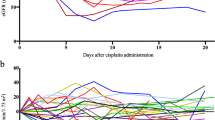Abstract
Experimental evidence suggests that anthracyclines, widely used in cancer chemotherapy, may impair kidney function. We assessed kidney function by serum creatinine, urinary N-acetyl-β-D-glucosaminidase activity indices (NAGi) and microalbuminuria (MA) in 160 serum and urine samples obtained from 66 children with cancer. The effect of dexrazoxane was analyzed in 6 children on dexrazoxane supportive therapy in conjunction with daunorubicin (DNR) treatment, as compared with 6 children not receiving this agent. NAG; was significantly (p<0.05) elevated after treatment by DNR, doxorubicin, epirubicin (EPI) and idarubicin (IDA). MA proved to be a less sensitive indicator of kidney damage than NAGL DNR resulted in a progressive deterioration of proximal tubular function as determined by linear regression analysis. The mean NAG1 in the dexrazoxanetreated group was significantly (p<0.005) lower than in children not receiving dexrazoxane prior to DNR treatment. In conclusion, our study demonstrated that DNR, EPI and IDA induced an acute renal tubular damage similar to known tubulotoxic agents as cisplatin, carboplatin, cyclophosphamide and ifosfamide. The damage was clinically mild and only a minor proportion of patients can be expected to develop long-lasting tubulopathy with negative impact on the quality of life.
Similar content being viewed by others
Abbreviations
- NAGi:
-
N-acetyl-β-D-glucosaminidase activity normalized for urinary creatinine concentration
- MA:
-
microalbuminuria
- DNR:
-
daunorubicin
- DXR:
-
doxorubicin
- CDDP:
-
cisplatin
- CARBO:
-
carboplatin
- CYC:
-
cyclophosphamide
- VCR:
-
vincristine
- EPI:
-
epirubicin
- IDA:
-
idarubicin
- IFO:
-
ifosfamide
- MHSCUD:
-
Medical and Health Science Center of the University of Debrecen
- HPOG:
-
Hungarian Pediatric Oncology Group
- ALL:
-
acute lymphoblastic leukemia
- NHL:
-
non-Hodgkin lymphoma
- SR:
-
standard risk
- IR:
-
intermediate
- HR:
-
high risk
- ECG:
-
electrocardiography
- SD:
-
standard deviation
- CARBO:
-
carboplatin
- IFO:
-
ifosfamide
- ASCO:
-
American Society of Clinical Oncology
References
Bárdi E, Bobok I, Oláh VA, et al: Cystatin C is a suitable marker of glomerular function in children with cancer. Pediatr Nephrol 10:1145–1147, 2004
Deprez-DeCampeneere D, Jaenke R, Trouet A: Comparative cardiac and renal toxicity of daunorubicin in the rat and rabbit. Cancer Treat Rep 66: 395–397, 1982
Kobayashi H: Cisplatin and ovarian carcinoma — early detection of cisplatin-induced nephrotoxicity. Nippon Sanka Fujinka Gakkai Zasshi 37:888–896, 1985
Zoubek A, Holzinger B, Mann G, et al: High-dose cyclophosphamide, adriamycin, and vincristine (HD-CAV) in children with recurrent solid tumor. Pediatr Hematol Oncol 11:613–623, 1994
Kopecna L: Late effects of anticancer therapy on kidney function in children with acute lymphoblastic leukemia. Bratisl Lek Listy 102:357–360, 2001
Kakihara T, Imai C, Uchiyama M, et al: Impaired tubular excretory function as a late side effect of chemotherapy in children. J Pediatr Hematol Oncol 25:209–214, 2003
Bárdi E, Oláh VA, Bartyik K, et al: Late effects on renal glomerular and tubular function in childhood cancer survivors. Pediatr Blood Cancer 43:668–673, 2004
Schrappe M, Reiter A, Zimmermann M, et al: Long-term results of four consecutive trials in childhood ALL performed by the ALL-BFM study group from 1981 to 1995, Berlin-Frankfurt Munster. Leukemia 14: 2205–2222, 2000
Creutzig U, Ritter J, Zimmermann M, et al: Improved treatment results in high-risk pediatric acute myeloid leukemia patients after intensification with high-dose cytarabine and mitoxanthrone: results of Study Acute Myeloid Leukemia-Berlin-Frankfurt-Munster 93. J Clin Oncol 19: 2705–2713, 2001
Reiter A, Schrappe M, Parwaresch R, et al: Non-Hodgkin’s lymphomas of childhood and adolescence: results of a treatment stratified for biologic subtypes and stage — a report of the Berlin-Frankfurt-Munster Group. J Clin Oncol 13:359–372, 1995
Schellong G, Potter R, Bramswig J, et al: High cure rates and reduced long-term toxicity in pediatric Hodgkin’s disease: the German-Austrian multicenter trial DAL-HD-90. The German-Austrian Pediatric Hodgkin’s Disease Study Group. J Clin Oncol 17:3736–3744, 1999
Marx M, Langer T, Graf N, et al: Multicentre analysis of anthracycline-induced cardiotoxicity in children following treatment according to the nephroblastoma studies SIOP No. 9/ GPOH and SIOP 93-01/ GPOH. Med Pediatr Oncol 39:18–24, 2002
Ozaki T, Flege S, Kevric M, et al: Osteosarcoma of the pelvis: experience of the Cooperative Osteosarcoma Study Group. J Clin Oncol 21:334–341, 2003
Koscielniak E, Jurgens H, Winkler K, et al: Treatment of soft tissue sarcoma in childhood and adolescence. A report of the German Cooperative Soft Tissue Sarcoma Study. Cancer 70:2557–2567, 1992
Ninane J, Perilongo G, Stalens JP, et al: Effectiveness and toxicity of cisplatin and doxorubicin (PLADO) in childhood hepatoblastoma and hepatocellular carcinoma: a SIOP pilot study. Med Pediatr Oncol 19:199–203, 1991
Joffe M: On the precipitation that picric acid produces in normal urine, and on a new reaction of creatinine [in German]. Zietschrift Physiol Chem 10: 391–400, 1986
Olóh VA, Csathy L, Pocsi I, et al: Reference ranges for urinary NAG indices in healthy children determined with three colorimetric methods. Ann Clin Biochem 31:87–88, 1994
Hensley ML, Schlichter LM, Lindley C, et al: American Society of Clinical Oncology Clinical practice guidelines for the use of chemotherapy and radiotherapy protectants. J Clin Oncol 17:3333–3355, 1999
Herman EH, Zhang J, Chadwick DP, Ferrans VJ: Comparison of the protective effects of amifostine and dexrazoxane against the toxicity of doxorubicin in spontaneously hypertensive rats. Cancer Chemother Pharmacol 45:329–334, 2000
Author information
Authors and Affiliations
Corresponding author
Rights and permissions
About this article
Cite this article
Bárdi, E., Bobok, I., Oláh, A.V. et al. Anthracycline antibiotics induce acute renal tubular toxicity in children with cancer. Pathol. Oncol. Res. 13, 249–253 (2007). https://doi.org/10.1007/BF02893506
Received:
Accepted:
Issue Date:
DOI: https://doi.org/10.1007/BF02893506




